This summer I went to Europe with my nieces. We visited Zurich, Krakow, Prague and Berlin. My suitcase unfortunately did not make the journey with me. At each stop, I updated Swiss Air about my location. It took 8.5 days (of the 10 we were there) for my suitcase to meet up with me. I was annoyed, and eventually had to purchase clothing in each town, and do some hand-washing to have clean clothing!
While in Krakow, which was chosen because I wanted to go to Auschwitz, I decided to go to Schindler’s Factory. As a history teacher, I have seen the movie dozens, more than dozens, of times, as I show it to both my Academic and Applied history classes every year. The opportunity to actually go in was irresistible.
I walked almost a kilometer in the cool 16 degree rain, took a tram, then a bus and then another 1 km walk to the factory. Feeling very miserable and sorry for myself, I waited in the line outside the museum, (based in what was the office of the former factory) in the rain. I dislike standing in cold rain and I did not have proper footwear or clothing because of my lost suitcase.
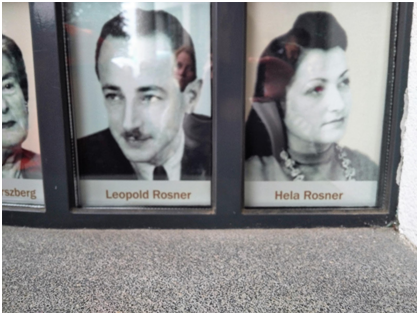 Schindler’s Factory, photo by J. Haskings-Winner
Schindler’s Factory, photo by J. Haskings-Winner
I use Schindler’s List in my grade 10 history classes every year as it demonstrates accurately, for students who learn visually, the conditions of the ghetto, and the concentration camps. It also models clearly that upstanders have choices. Beyond Schindler, who was both a war profiteer and one who spent his millions to save the Jewish workers, there is also a powerful moment at the end, when the soldiers were ordered to kill the “Schindler" Jews. One single anonymous soldier turns, and leaves. The rest follow. An anonymous soldier makes a choice, disobeys orders, and no one dies.
History is about individual choices. As I toured Schindler’s factory with an excellent tour guide, there were many opportunities to learn about some of these choices. The connection to Schindler in the museum is really limited to the location and the images outside. Inside, our tour guide took pains to include a variety of historical perspectives: Jewish, Polish and German, but not much about Schindler himself. I learned about decisions and choices of many individuals throughout the tour. Stories of survivors, Polish resistance, and to my shock, that the Nazis killed teachers and professors first. This is something to discuss with students – why?
For the academic students, I start teaching the Holocaust as we finish learning about the Depression, which includes relevant events in Canada. I teach in the Beach area of Toronto, which was the home to the Swastika Club in the 1930s. Students are shocked to learn of events in their neighbourhood. They learn of the Christie Pits riot, and the S.S. St. Louis. I show Pigeon to the students to reinforce the concept of upstander. This leads into events of the Holocaust and then they watch Schindler’s List. Students then create a timeline of the six most historically significant events in the Holocaust, before we move into events of WWII. Their unit culminating task is a “timeline with attitude”, (Seixas, Morton. The Big Six), in which they select the top 10 events between 1929-1945 and look for the event that was the turning point. They write a defence of the most historically significant event to accompany their timeline.
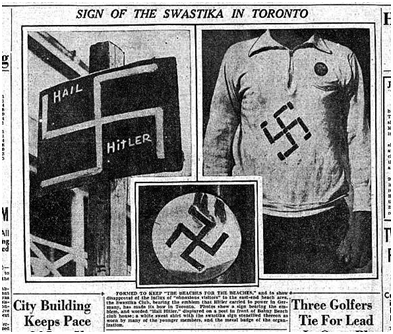 Beaches Swastika Club,Telegram August 1 1933 Toronto. This is the neighbourhood I teach in.
Beaches Swastika Club,Telegram August 1 1933 Toronto. This is the neighbourhood I teach in.
For my Applied History class, I take a different approach. With them, I teach World War II and then go back to the Holocaust. They work on their unit culminating task in class, as they watch Schindler’s List. I usually show about 35-45 minutes/class and the rest is time to work on their unit culminating task.The culminating is a set of WWII Collector cards (sort of like baseball cards). They research and record the 5 Ws, Causes and Consequences (intended/unintended) as well as an image on the front, and then select the most historically significant event, using the criteria for historical significance that they defend in a paragraph (or oral presentation). For some more information check out the OHASSTA posters and website.
The next day my nieces and I visited Auschwitz I and II. I did not realize how close they were to each other. Being there, seeing the train car, the gas chamber, the ovens, the living quarters, it was quite overwhelming. “Schindler’s List” uses very authentic images, based on my experience visiting Auschwitz.
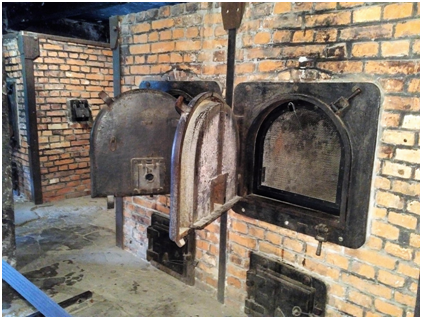 Auschwitz. Photo by J. Haskings-Winner
Auschwitz. Photo by J. Haskings-Winner
My missing suitcase did reappear, but after my visit to Auschwitz I was reminded that its original disappearance was really only a minor annoyance. Although I spent a lot of time in the rain, I was able to take a taxi from the Schindler’s factory to the hotel. Those in Auschwitz had no such luxury. Their suitcases and possessions were not returned and they could not go inside when it rained or snowed.
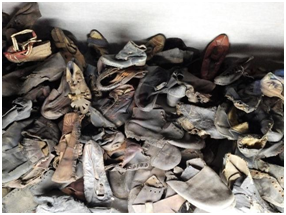 Shoes of victims of the Nazis now in the museum at Auschwitz photo by J. Haskings-Winner
Shoes of victims of the Nazis now in the museum at Auschwitz photo by J. Haskings-Winner
In Berlin, we visited the Memorial to the Murdered Jews of Europe which opened in 2005. It is somewhat controversial, but the sheer size makes a statement. Each city, steeped in centuries of history revealed some of their stories, but there is more to learn.
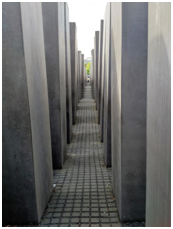 Memorial to the Murdered Jews of Europe, Berlin Germany. Photo by J. Haskings-Winner
Memorial to the Murdered Jews of Europe, Berlin Germany. Photo by J. Haskings-Winner
I will continue to show Schindler’s List. I recently met a student I taught in grade 10 applied history two years ago. She asked about my summer and when I reported I had been to Schindler’s Factory, her eyes widened and our conversation continued as she asked what I saw and learned and how my experience at the factory compared to the movie. Students need to be engaged to understand history, to know that history is about individual choices and these choices matter. I believe this engagement is why a student from several years ago was curious about my experiences in a place she had experienced through the movie.
To be an upstander in their own lives will be how students are active citizens for the future. History provides the examples and the opportunity to discuss the consequences of individuals' choices.
Now Consider:
How have you used Schindler’s List in your classroom?
What other movies have you used in order to help students connect to history?
How do you talk to students about being upstanders and active citizens?

